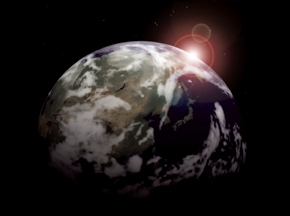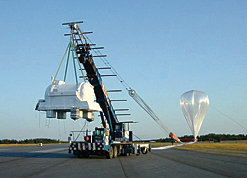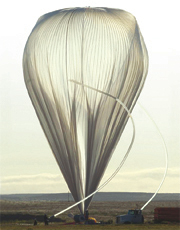Space Science Center Balloon Program Gets Pumped
IT'S BEEN 20 YEARS since researchers in the Space Science Center sent scientific payloads up and away via balloon. We’re not talking about projects like BalloonWinds, which investigate our own atmosphere, but high-energy astrophysics experiments aimed at probing the distant reaches of the cosmos.
Now, two recently funded NASA projects have reinflated the balloon program. The Gamma-Ray Polarimeter Experiment or GRAPE received $2 million from NASA with plans for a full scientific payload to be launched by balloon in the fall of 2011. The goal of the mission is to measure x-ray polarization in pulsars, gamma-ray bursts, and solar flares. Mark McConnell is the principal investigator.
And for a mission that will, in a sense, pick up the SSC balloon program where it left off, Jim Ryan will lead a team developing a smaller, improved version of the telescope UNH scientists and engineers created for the Compton Gamma-Ray Observatory (CGRO). The three-year, half-million-dollar project known as the Fast Compton Telescope (FACTEL) aims to fly an engineering model of the telescope in the fall of 2010.
Notes McConnell, who 25 years ago was a graduate student working with Ed Chupp on balloon-based experiments, “The last balloon flight was in 1988 and then the focus shifted towards CGRO, which was launched in 1991. We never did get back into balloons.”
In part, the beauty of a reinvigorated balloon program is that it provides students—both graduate and undergraduate—unique opportunities to work on a mission soup to nuts.
“Students get to design, build, fabricate, fly, and analyze data – everything in the space of a few years. It’s not like satellite work, which is typically stretched over many years and involves a large team of engineers and scientists, where everybody specializes and where there’s lots of quality control,” McConnell says.
There is, of course, quality control for balloon work as well. But McConnell recalls one long-ago mission, dubbed “Gamma-Busters,” in which they duct-taped a stuffed teddy bear (“Buster Bear”) to the gondola in an effort to conjure up some good luck; two previous launches had ended in balloon failure. The balloon went up and they collected gamma-ray data for 40 hours—a very successful balloon flight.
In 2007, a small engineering prototype of the GRAPE experiment flew on a high-altitude balloon in a successful proof-of-concept flight. Now, with full funding for three years, McConnell and team hope to send a large array of the gamma-ray detectors built at the SSC to further validate the science in a one- to two-day flight. With success, the next step would be a balloon mission launched from Antarctica where balloons can catch the polar winds and circle the Earth for 30 days.
GRAPE is designed first and foremost to study gamma-ray bursts—massive ejections of high-energy particles and photons from dying stars or supernovae. The ejection is thought to take the form of a narrow jet moving outward at nearly the speed of light. If the jet happens to point towards the Earth, the beam of explosive radiation will be seen in the form of a gamma-ray burst. Most of these events are missed, but were GRAPE to orbit the South Pole for 30 days perhaps a dozen gamma-ray bursts could be recorded.
Says McConnell, “We think that the beam is the source of the high-energy radiation, but the structure of that beam and the mechanism by which the high-energy radiation is generated is not entirely clear. There are lots of theories, but to test them we need data like those GRAPE can provide.”
The FACTEL mission will build upon the highly successful Imaging Compton Telescope (COMPTEL) that flew on NASA’s Gamma-Ray Observatory from 1991-2000. The design will be an upgraded version of the telescope—using the latest technologies, like detectors and electronics—that should make it orders of magnitude more sensitive and produce much sharper imagery.
“COMPTEL looked at a part of the gamma-ray spectrum that is notoriously difficult to view,” McConnell says. “FACTEL will be able to see fainter sources and have finer angular resolution allowing us to map out the distribution of radioactive materials in the galaxy much better.”
Now, two recently funded NASA projects have reinflated the balloon program. The Gamma-Ray Polarimeter Experiment or GRAPE received $2 million from NASA with plans for a full scientific payload to be launched by balloon in the fall of 2011. The goal of the mission is to measure x-ray polarization in pulsars, gamma-ray bursts, and solar flares. Mark McConnell is the principal investigator.
A NASA scientific balloon prepares to lift an experiment.Photo: NASA |
Notes McConnell, who 25 years ago was a graduate student working with Ed Chupp on balloon-based experiments, “The last balloon flight was in 1988 and then the focus shifted towards CGRO, which was launched in 1991. We never did get back into balloons.”
In part, the beauty of a reinvigorated balloon program is that it provides students—both graduate and undergraduate—unique opportunities to work on a mission soup to nuts.
“Students get to design, build, fabricate, fly, and analyze data – everything in the space of a few years. It’s not like satellite work, which is typically stretched over many years and involves a large team of engineers and scientists, where everybody specializes and where there’s lots of quality control,” McConnell says.
There is, of course, quality control for balloon work as well. But McConnell recalls one long-ago mission, dubbed “Gamma-Busters,” in which they duct-taped a stuffed teddy bear (“Buster Bear”) to the gondola in an effort to conjure up some good luck; two previous launches had ended in balloon failure. The balloon went up and they collected gamma-ray data for 40 hours—a very successful balloon flight.
In 2007, a small engineering prototype of the GRAPE experiment flew on a high-altitude balloon in a successful proof-of-concept flight. Now, with full funding for three years, McConnell and team hope to send a large array of the gamma-ray detectors built at the SSC to further validate the science in a one- to two-day flight. With success, the next step would be a balloon mission launched from Antarctica where balloons can catch the polar winds and circle the Earth for 30 days.
GRAPE is designed first and foremost to study gamma-ray bursts—massive ejections of high-energy particles and photons from dying stars or supernovae. The ejection is thought to take the form of a narrow jet moving outward at nearly the speed of light. If the jet happens to point towards the Earth, the beam of explosive radiation will be seen in the form of a gamma-ray burst. Most of these events are missed, but were GRAPE to orbit the South Pole for 30 days perhaps a dozen gamma-ray bursts could be recorded.
Says McConnell, “We think that the beam is the source of the high-energy radiation, but the structure of that beam and the mechanism by which the high-energy radiation is generated is not entirely clear. There are lots of theories, but to test them we need data like those GRAPE can provide.”
The FACTEL mission will build upon the highly successful Imaging Compton Telescope (COMPTEL) that flew on NASA’s Gamma-Ray Observatory from 1991-2000. The design will be an upgraded version of the telescope—using the latest technologies, like detectors and electronics—that should make it orders of magnitude more sensitive and produce much sharper imagery.
“COMPTEL looked at a part of the gamma-ray spectrum that is notoriously difficult to view,” McConnell says. “FACTEL will be able to see fainter sources and have finer angular resolution allowing us to map out the distribution of radioactive materials in the galaxy much better.”
by David Sims, Science Writer, Institute for the Study of Earth, Oceans, and Space. Published in Fall 2008 issue of EOS .


